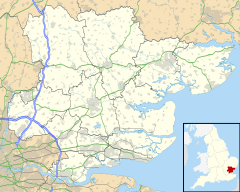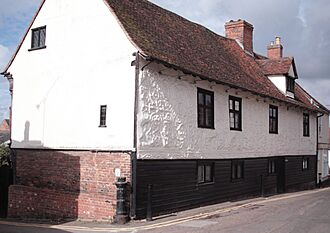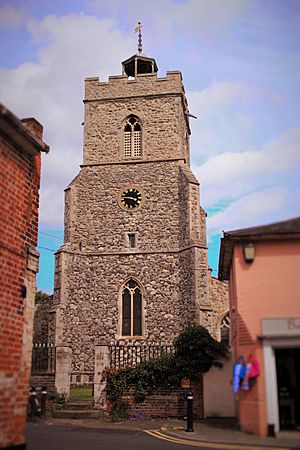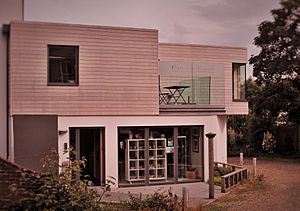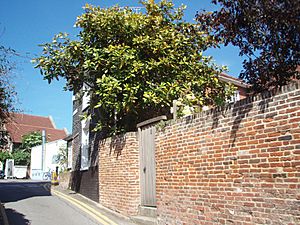Wivenhoe facts for kids
Quick facts for kids Wivenhoe |
|
|---|---|
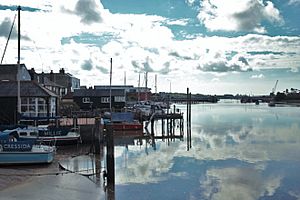 Wivenhoe riverfront on the River Colne |
|
| Population | 7,637 (2011) |
| OS grid reference | TM045225 |
| Civil parish |
|
| District |
|
| Shire county | |
| Region | |
| Country | England |
| Sovereign state | United Kingdom |
| Post town | COLCHESTER |
| Postcode district | CO7 |
| Dialling code | 01206 |
| Police | Essex |
| Fire | Essex |
| Ambulance | East of England |
| EU Parliament | East of England |
| UK Parliament |
|
Wivenhoe is a town and civil parish in the Colchester area of north-eastern Essex, England. It is about 3 kilometres (2 miles) south-east of Colchester.
Historically, Wivenhoe was two separate places: Wivenhoe village by the River Colne and Wivenhoe Cross on higher ground. Over time, especially in the 1800s, they grew together and became one town.
In 2011, Wivenhoe had a population of 7,637 people. The town's history is strongly linked to fishing, building ships, and even smuggling. Many parts of lower Wivenhoe are protected as a conservation area because of their special buildings and streets.
Contents
What's in a Name?
The name Wivenhoe comes from old English words. It means "Wifa's" or "Wife's" spur or promontory (a piece of land sticking out). People usually say "Wivvenho" today, but in the past, people in Essex might have said "Wivvenhoo."
There's also a fun story that the name comes from "Wyvernhoe," linked to a mythical creature called a wyvern. The town's football team, Wivenhoe Town FC, is even nicknamed 'The Wyverns'!
A Look Back in Time
Wivenhoe is mentioned in the Domesday Book from 1086, which was a big survey of England. It was called Wiivnhou back then and had a mill, meadows, and pasture for sheep.
The oldest building still standing in Wivenhoe is St. Mary the Virgin Church. It was first mentioned in 1254. Parts of the church were built in the 1340s and 1350s.
Wivenhoe grew into an important port. For a long time, it was the main port for Colchester because large ships couldn't go further up the River Colne. Wivenhoe became known for its shipbuilding, trade, and fishing, especially for oysters and sprats. The town became even more successful when the railway arrived in 1863.
In 1884, Wivenhoe was hit by a very strong earthquake, one of the biggest ever in the UK. In the 1960s, Wivenhoe Park was chosen as the home for the University of Essex.
Wivenhoe Park
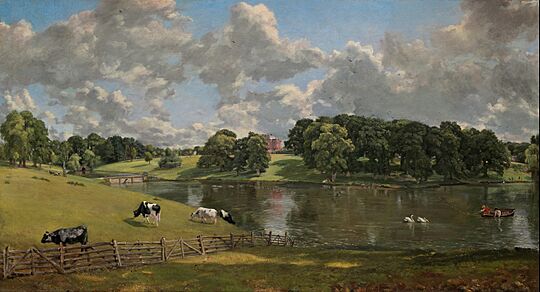
Wivenhoe Park is right next to Colchester and is where the University of Essex is located. For many centuries, the Rebow family, who were Flemish cloth weavers, lived here.
The main house, Wivenhoe House, was designed in 1759. The park itself was designed by Richard Woods and later changed in 1846–1847. A famous painting of the house across the lake was made by the artist John Constable in 1816.
Getting Around
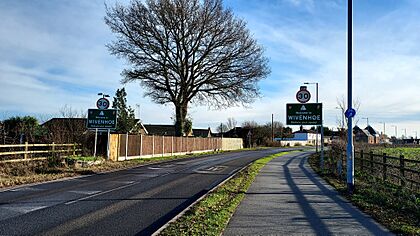
Wivenhoe railway station is on the Sunshine Coast Line. This line connects Colchester to seaside towns like Clacton-on-Sea and Walton-on-the-Naze. You can catch direct trains from Wivenhoe to these towns and also to London Liverpool Street. There used to be a train line from Wivenhoe to Brightlingsea, but it closed in 1964.
During warmer months, you can take a special foot ferry across the River Colne to Fingringhoe and Rowhedge. There are also boat services from Brightlingsea in the summer.
Local bus services are available, connecting Wivenhoe to Colchester and Clacton. Wivenhoe is also about an hour away from Stansted Airport and 30 minutes from Harwich International Port.
Life in Wivenhoe
Wivenhoe has a population of around 9,000 to 10,000 people. It's a mix of students from the University of Essex, artists, and people who travel to work.
The town has many small local shops. You can find a bookshop, a chemist, post offices, a coffee shop, a toy shop, a deli, and an art gallery. There are also five pubs, some of which host music events like a jazz club. The Crab & Winkle Gallery is located at the town's railway station. Many university students enjoy walking from the campus to visit the town's pubs and waterfront.
Wivenhoe has lots of sports and leisure clubs. The Wivenhoe Sailing Club is by the river. Wivenhoe Town Football Club plays at Broad Lane Sports Ground, which is also used by Colchester United Ladies and the Wivenhoe Tennis Club. Wivenhoe Town Cricket Club is on Rectory Road. There are also music and theatre groups. The King George V Playing Field has a small skate park, football pitches, and a play area.
News and Media
For local news and TV, Wivenhoe gets programmes from BBC East and ITV Anglia. Local radio stations include BBC Essex and Heart East. The town is also served by local newspapers like the Colchester Gazette and Essex County Standard.
Learning and Education
Wivenhoe has two primary schools: Broomgrove Infant and Junior, and Millfields Primary.
For older students, secondary schools are in the surrounding areas. The University of Essex has been located at Wivenhoe Park since 1964.
Famous People from Wivenhoe
The actor-manager Sir John Martin-Harvey was born in Wivenhoe in 1863. He is remembered with a blue plaque on Quay House, one of his childhood homes. His family were well-known yacht builders.
The pianist and entertainer Semprini (1908–1990) lived in Wivenhoe during his retirement.
Wivenhoe was also home to actress Joan Hickson (1906–1998), who famously played Miss Marple in the BBC TV shows based on Agatha Christie's books. Children's author and journalist Leila Berg (1917–2012) also lived here. She was known for creating the 'Nippers' series of books, which aimed to include stories about working-class and minority families for children.
British academic Anthony Everitt (born 1940), who writes for The Guardian and The Financial Times, also lives in Wivenhoe. Other residents include poet and musician Martin Newell, writer A. L. Kennedy, and painter James Dodds. The singer Polly Scattergood was born in Wivenhoe.
The famous painter Francis Bacon owned a house in Wivenhoe where he would visit his artist friends, Dickie Chopping and Denis Wirth-Miller. Journalists George Gale and Peregrine Worsthorne also had homes in the lower part of the town.
The musician Keith Christmas was born in Wivenhoe in 1946 and lived there until 1961.
Images for kids
See also
 In Spanish: Wivenhoe para niños
In Spanish: Wivenhoe para niños


